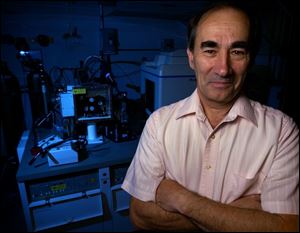
State awards funds for protein research
7/19/2003
Dr. Ronald Viola, a chemistry professor at the University of Toledo, will lead the research on protein structure.
Dr. Ronald Viola, a chemistry professor at the University of Toledo, likes to get to know his proteins intimately.
“Proteins are kind of like people. Each one has its own personality,” he says.
Because of a $1.18 million state grant approved by the Ohio Board of Regents, he expects to get an even better understanding of the fabulous, folding molecules.
As the leader of a consortium that was one of eight winners of the Hayes Investment Fund Awards, UT will use most of the funds to purchase equipment that should give it unique capabilities in the Midwest in the study of protein structure, Dr. Viola said.
“Our focus is to be able to solve the structure of proteins and improve our understanding of how they work,” he said.
One machine, at a cost of about $200,000, will automate the process of crystallizing proteins, which do the work in our cells. Currently, the procedure is very time consuming because it has to be done by hand, Dr. Viola said.
Proteins must be crystallized so that the atoms are rigidly aligned when they are placed in another machine called an X-ray diffractometer. The machine shoots X-rays through the crystal in order to help reconstruct a 3-D map of the protein's atoms.
The grant will allow UT to buy a dramatically more powerful diffractometer for about $800,000, Dr. Viola said.
Since a protein's function follows its form, knowing what it looks like is essential for companies developing drugs to interact with them.
“If you know what the protein structure looks like, then scientists can create something to connect to it and block its function,” he said.
Garrison Walters, the regents' vice chancellor for academic affairs and economic advancement, said the program should tie in well with Gov. Bob Taft's Third Frontier initiative to help develop Ohio's high-tech and biotechnology industry.
“This is the kind of infrastructure research that will be of extraordinary value to a wide range of centers and programs in life science research,” he said.
There were 44 proposals submitted for the state grants, and only eight recipients. Ohio State University was the lead institution with five of the winners.
“We're moving up into pretty rarified air with this,” Dr. Viola said, adding that the equipment should draw plenty of interest from researchers around the Midwest.
Indeed, the award represents a big step for research at UT, said Dr. Frank Calzonetti, vice provost for research.
Last year, UT brought in $27.3 million in research funding, so an award of this size is very significant. “It shows that we really have a strong X-ray crystallography group at the university here that can really stand up against anybody,” Dr. Calzonetti said. “This is one of our premier areas.”